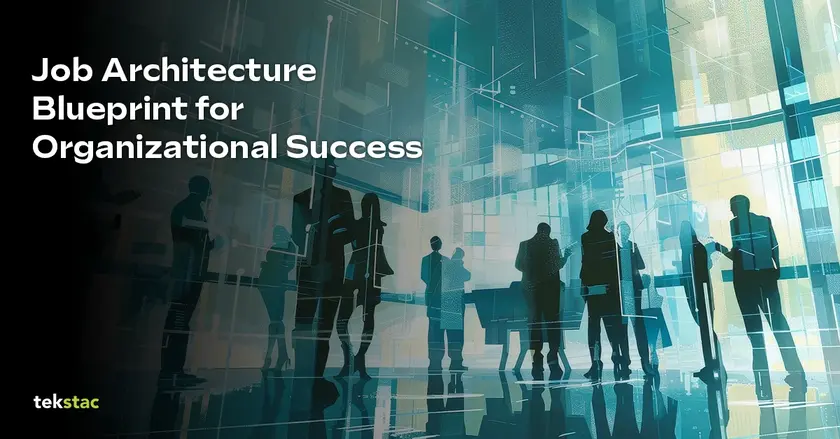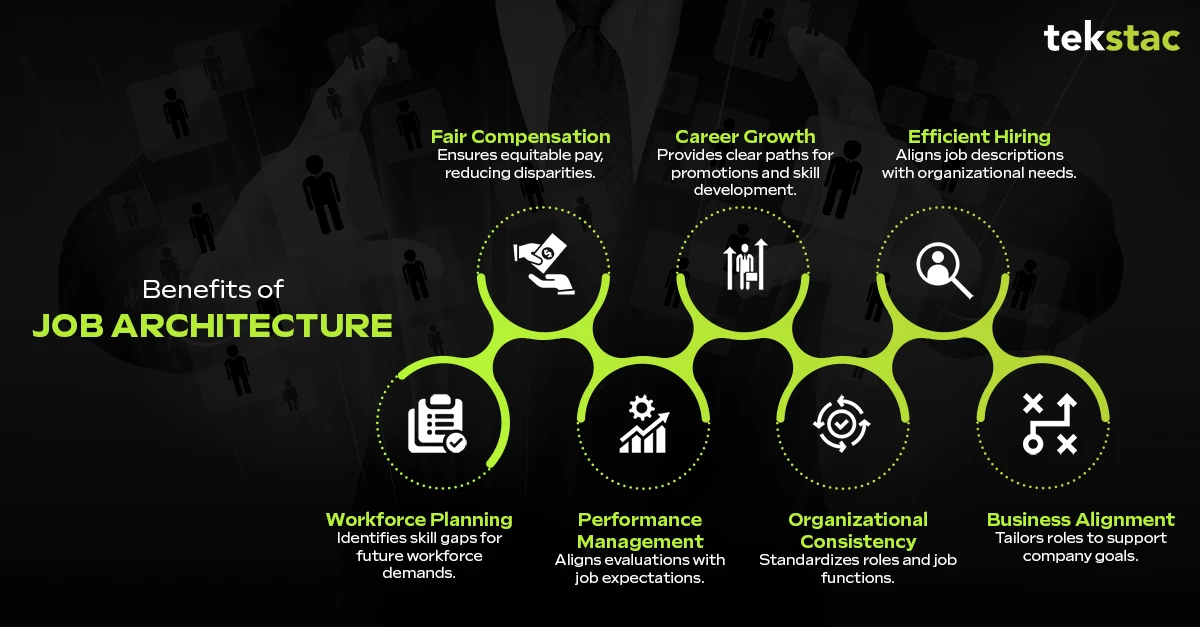What is Job Architecture and Why is It Crucial for Organizational Success?
January 28, 2025

What is Job Architecture?
Job architecture refers to the systematic method of organizing jobs inside a company. It encompasses naming the job titles, defining the employees’ roles, and outlining the levels. This results in an understanding of the organizational structure of its employees, thereby making it easier for all staff to know where they belong and how the jobs are related to one another.
This framework is significant and indispensable for employees and employers alike. On the one hand, employees can see their position and possible career growth. On the other hand, it will make hiring, payroll management, and future human resource planning easier. In short, the job architecture establishes the foundation of a more controlled, efficient, and desirable workplace.
Why Job Architecture Matters for Organizations
This gradual work structure for your company, known as job architecture, defines the job families, job roles, expected behaviors, levels, and other factors necessary to build a thriving organization. It classifies jobs into distinct buckets depending on job function, level, and skill set needed.
Establishing this job architecture creates a standardized basis for the organization’s titles, job descriptions, and compensation. This supports more equitable and transparent decision-making. Job architecture also standardized workforce planning and employee development skills required for specific roles with business objectives.
The need for a clear and equitable organizational structure. Leaders should practice real-time mapping toward career progression to promote such conversations. For potential employers, it streamlines hiring and performance management and salary benchmarking.
Key Benefits of Job Architecture
- Fair Compensation Structure: Ensures consistent and equitable pay for similar roles, reducing pay disparities.
- Career Growth Opportunities: Provides a transparent path for promotions and skill development, boosting employee morale and retention.
- Streamlined Recruitment: Simplifies the hiring process by aligning job descriptions with organizational needs.
- Improved Workforce Planning: Helps managers identify skill gaps and plan for future workforce demands effectively.
- Enhanced Performance Management: Aligns performance evaluations with job expectations, fostering accountability and development.
- Consistency Across the Organization: Creates uniformity in job titles and functions, reducing confusion and promoting collaboration.
- Stronger Alignment with Business Goals: Ensures roles and responsibilities are tailored to support organizational objectives.

Step-by-Step Process to Develop Job Architecture
1. Understand Organizational Goals
A good place to begin is by researching the company’s strategic position regarding its mission, vision, and scope of strategic objectives. This step is rather important because the job architecture should correspond to and also stimulate the organization’s direction.
For instance, when a company targets innovation, the jobs must generate positions responsible for research and creativity. Awareness of these goals helps ensure the framework can foster development, optimization, and overall compliance with major strategic objectives.
2. Analyze Current Roles and Structures
Take a comprehensive review of the organization’s existing roles, job descriptions, and reporting structures. Look for discrepancies among the levels, areas where responsibilities are closed or missing, and hierarchy gaps.
In some cases, there may be several job titles that are similar or critical roles that are not clearly defined. This assessment is an important part of reorganization and an effective way to avoid not including an important task.
3. Group Similar Roles
Organize jobs with activities or tasks in clusters of their day-to-day activities, responsibilities or skills needed. For example, assigning customer assistance, sales, and marketing jobs can be placed categorically under a broader function.
This classification helps identify duplications of work and match positions with the company’s functional needs It also helps employees visualize their relationships to other positions within the company.
4. Outline Responsibilities and Skills
Explain the purpose and responsibilities, the requirements of the job, and the skills essential for the job. This stage ensures that the job descriptions prepared are well defined, accurate, and oriented toward achieving the firm’s objectives.
It will also involve tasks such as campaign planning, team leadership, performance evaluation, some degree of strategic thinking, and, last but not least, communication skills.
5. Implement and Communicate
After finalizing the job architecture, release it to the organization. Describe the new framework’s impact, advantages, and goal. Provide training sessions to help managers understand how to implement it in their departments. For instance, they could require instructions on how to use job descriptions for promotions or performance assessments.
6. Monitor and Update Regularly
An effective job architecture is dynamic. Make sure the structure is still appropriate when the business expands or changes by reviewing it regularly. For instance, if a sector is reshaped by new technology, some jobs might need new skills or new positions would need to be created.
Maintaining the framework guarantees that it will continue to provide a solid basis for organizational success.
How Job Architecture Drives Business Growth and Employee Engagement
Job architecture is the foundation of a well-run, effective company. It promotes openness, equity, and alignment with corporate objectives by precisely outlining positions, duties, and career pathways. Employers may streamline operations, from workforce planning to recruitment, using this systematic method, improving employee engagement and retention.
A solid job architecture lays the foundation for long-term success by promoting staff retention and supporting effective organizational change. It also helps businesses find new opportunities with confidence. This approach creates a structured and goal-oriented work environment where motivation thrives and teams are empowered to drive sustainable growth.
FAQs on Job Architecture
1. What is the primary purpose of job architecture?
Job architecture aims to provide a clear structure for organizing roles, responsibilities, and career paths within an organization. It ensures consistency, fairness, and alignment with business objectives.
2. How does job architecture benefit employees?
Job architecture clarifies employees’ roles, responsibilities, and potential career growth. It provides transparency in pay structures and a clear path for skill development and advancement.
3. How often should job architecture be updated?
Job architecture should be reviewed regularly, especially when there are significant organizational changes, new industry trends, or shifts in business goals. Regular updates ensure the structure remains relevant and effective.





